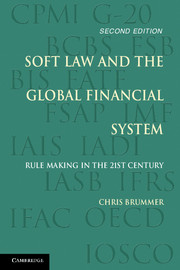Book contents
- Frontmatter
- Contents
- Preface to the New Edition
- Acknowledgments
- Key Abbreviations
- Introduction: The Perils of Global Finance
- 1 Territoriality and Financial Statecraft
- 2 The Architecture of International Financial Law
- 3 A Compliance-Based Theory of International Financial Law
- 4 How Legitimate is International Financial Law?
- 5 Soft Law and the Global Financial Crisis
- 6 Implementing the G-20 Agenda: A Transatlantic Case Survey
- 7 The Future of International Financial Law
- Index
2 - The Architecture of International Financial Law
Published online by Cambridge University Press: 05 November 2015
- Frontmatter
- Contents
- Preface to the New Edition
- Acknowledgments
- Key Abbreviations
- Introduction: The Perils of Global Finance
- 1 Territoriality and Financial Statecraft
- 2 The Architecture of International Financial Law
- 3 A Compliance-Based Theory of International Financial Law
- 4 How Legitimate is International Financial Law?
- 5 Soft Law and the Global Financial Crisis
- 6 Implementing the G-20 Agenda: A Transatlantic Case Survey
- 7 The Future of International Financial Law
- Index
Summary
Financial globalization makes international engagement necessary as mobile market participants and capital more easily escape unilateral national regulatory supervision. Regulatory authorities have responded to the challenge by seeking to promulgate global standards, best practices, and prudential guidelines through a range of international forums and organizations. That international institutions should constitute focal points for such interactions is not surprising. Because of the constantly evolving nature of the global capital markets, many problems require continuous attention and new policy solutions rather than one-shot solutions. In such a world, corralling purely ad hoc alliances to deal with regulatory problems as they arise is a highly inefficient approach. Institutions help actors develop habits of cooperation and allow sustained attention to be brought to bear on common problems.
That said, the forums in which regulators participate are qualitatively different from those that have traditionally preoccupied theorists and practitioners of international law. Since the mid twentieth century, global rule making has been increasingly the province of “international organizations” – institutions defined by academics as grounded in a formal ratified treaty and enjoying “state membership, tangible manifestations of organizational bureaucracy, and an adequate legal pedigree.” Academics have extolled these features because they evince consent-based legitimacy: they require states to formally commit to participation along clearly demarcated terms specifying the powers and obligations of the body concerned. The powers accorded to such institutions have also often been considerable and include the ability to interpret the treaties on which they are based, adjudicate disputes, and supervise members’ conduct.
By contrast, in the international financial system, the production of international standards and rules arises through largely informal institutional arrangements grounded in nonbinding bylaws, charters, and accords – which, as such, are not recognized under international law. Nevertheless, these organizations are highly sophisticated institutional players in terms of both their internal design and their external orientation as pieces of a larger regulatory system. Individually, each employs varied strategies of rule production and monitoring. At the same time, organizations operate – despite their ostensibly “peer-to-peer” modes of technocratic cooperation – in hierarchical systems of regulatory influence and power. As a result, the operation of international financial law departs in significant ways from increasingly influential “trans-governmental” models of international governance that presume essentially egalitarian relationships and networks among regulators.
- Type
- Chapter
- Information
- Soft Law and the Global Financial SystemRule Making in the 21st Century, pp. 62 - 118Publisher: Cambridge University PressPrint publication year: 2015



